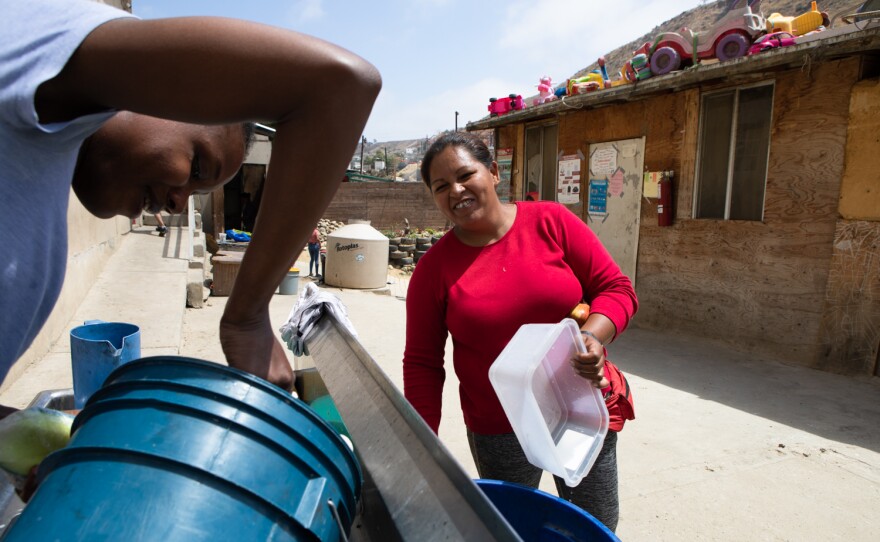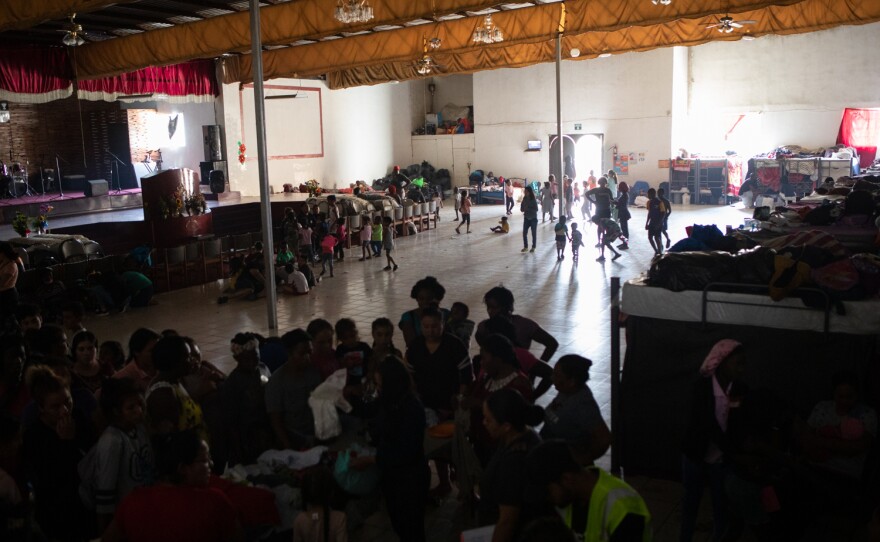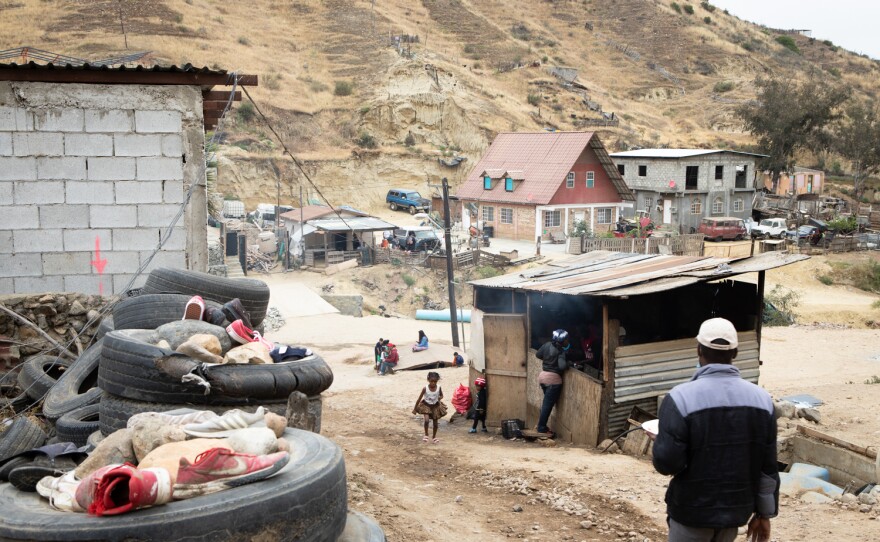Maritza Noemi Machado Velasquez cooks lunch for her two sons outside over an open fire at a migrant shelter in the outskirts of Tijuana.
The family whose journey from Honduras was treacherous — they were kidnapped for three months for ransom, she said — is comfortable at the shelter, where they hope to wait until they can ask for asylum in the United States.
Machado Velasquez is one of about 1,200 migrants at Templo Embajadores de Jesús, one of Tijuana’s highest-capacity migrant shelters. Pastor Gustavo Banda Aceves converted his church into a shelter in 2016.
Banda Aceves and other Tijuanenses have opened up their spaces to house migrants on the way to the U.S. who might otherwise be on the streets while they wait, some for months or even years, for the U.S. to reopen its asylum process. The U.S. closed doors to asylum seekers in 2020 under the pandemic-era health policy known as Title 42.
As a result, shelters such as Banda Aceves’, intended to temporarily care for migrants, are now housing migrants long-term, a need some say they’re poorly equipped to meet with their limited resources, which include little support from government sources.

And while the U.S. spends millions of dollars on humanitarian aid in Mexico — $60 million in fiscal year 2021 — some shelter leaders say the support isn’t reaching them. Covering the basic needs at Templo Embajadores de Jesús remains a significant challenge, Banda Aceves said.
Meanwhile, migrants who have been waiting for months to years to enter the U.S continue waiting there, “con paciencia,” Machado Velasquez said, preparing to serve lunch for her boys.
Shelters face growing need, elusive support
Across the city, Casa del Migrante has been sheltering migrants for more than three decades. Father Pat Murphy, director of the shelter, said seen Tijuana change along with the migrants who came.
“In 2016, there were five shelters. In Tijuana today there's over 30,” Murphy said. “And a lot of them were people with good hearts that just opened up the doors and really didn't have a long term plan.”
Tijuana has adapted to a growing migrant population living in limbo in the border city long-term as U.S. policies affecting the border like Title 42 have restricted asylum access.
Meanwhile U.S. aid to Mexico earmarked specifically for migrants at the northern borders has skyrocketed — from $1.4 million in 2019 to more than $20 million in 2020, according to an online government database for foreign aid. The following year, three times that amount was given for humanitarian aid in Mexico overall, according to federal officials.
But just two years later, some Tijuana shelters are still struggling to properly care for migrants living in them. And those shelter leaders say support from U.S.-backed organizations and Mexican government agencies aren’t fulfilling some of their most basic and urgent needs..
Lauded as exemplary, Casa del Migrante has relied on donations from individuals and grants from international organizations to support its programs and expansions over the years. More than room and board, the shelter offers medical, legal, psychological and employment services, children’s programming and a school for migrant adults at a nearby location.
The shelter has seen little help from government agencies in Mexico, though, Murphy said. The city of Tijuana has helped to cover water bills for the shelter, and food donations “once in a while,” but overall, since Mexico’s current president took over, the help for shelters has dropped significantly, according to Murphy.
During the pandemic, Casa del Migrante limited its capacity to 120, and today it still caps its capacity at that level — something that Murphy said makes it easier to provide quality services.
The shelter also limits migrants’ stays to 45 days. After that, they move out to rent a place in Tijuana or continue on their migration journey.
Other shelters, though, which cropped up in the last few years to meet a growing demand of migrants in the city, have struggled to ensure basic services.
“There was no long term plan for many of these shelters, churches with good intentions to open up the doors and help. And now they're a bit over their heads, building more buildings and places where they can't really take care of the people they have,” Murphy said.
U.S. officials said the $60 million disbursed to Mexico in 2021 was for humanitarian assistance. A portion of that funding benefitted migrants in northern Mexican border cities including Tijuana, though officials did not specify how much.
The Department of State Bureau of Population, Refugees, and Migration said in a statement that money funded “support for shelter, mental health and psycho-social support, gender-based violence responses, child protection needs, water, sanitation, and health activities, livelihoods, and legal assistance for asylum seekers, refugees, and vulnerable migrants.”
In the current fiscal year, the department said it has already distributed additional funding to support shelters and migrants’ basic needs, which included “a focus on improving shelter conditions along Mexico’s northern border, including in Tijuana,” a spokesperson for the department said.
In 2020, the U.S. funneled $21 million to fund programs for migrants at the northern border who were victims of trafficking and violent crime, otherwise vulnerable asylum-seekers, or enrolled in the Migrant Protection Protocols program, a Trump administration immigration policy that requires asylum seekers to wait in Mexico while their U.S. immigration case is processing.
The program, also known as Remain in Mexico, has been extended under the Biden administration after a federal judge ordered the program reinstated.
The jump in U.S. funding from 2019 to 2020 arrived the same year the Trump administration implemented Title 42 — effectively closing off the border to asylum seekers who normally have a right to ask for protection in the U.S. from persecution for race, religion, nationality, social group membership or political opinion in their home countries.
The money the U.S. distributes toward humanitarian assistance in Mexico flows through non-governmental organizations and international organizations such as the International Organization for Migration, a United Nations agency that helps to manage migration between governments and assist refugees and displaced populations.
The agency works with 22 migrant shelters in Tijuana, leading infrastructure improvements, delivering food, personal hygiene products, providing “e-wallets” for shelters to purchase food and advising migrants on fraud and extortion risks, misinformation about the border and requirements for securing identity documents in Mexico.

“I think we contribute, but it's not enough. And we cannot fulfill all of the needs that the migration situation has in Tijuana,” said Ana Paula Felix, Tijuana office coordinator with the International Organization for Migration.
Other international aid organizations provide support to Tijuana’s shelters through funding and partnerships with the U.S. government.
But the swell of migrants who have stayed in Tijuana long-term due to Title 42 and other policies has created “a new era” for the shelters, and a greater need in the city than those agencies can keep up with, said Enrique Lucero, director of migrant affairs at the city for Tijuana.
Migrants who, before the pandemic and Title 42, would normally stay a few weeks in the city before entering the U.S. now have stayed months to years, Lucero said.
“That is difficult for the shelters because they need to spend more money,” Lucero said.
The city of Tijuana works with shelters to relieve some of the pressure, including lowering the water and energy bills, providing medical attention and food and delivering donations from other organizations, Lucero said.
“We try to support them in everything they request,” Lucero said.
But the city can only assist shelters with the proper documentation from the government, which includes several permits, financials, proof of address and legal representation. Less than half of all shelters in the city meet those qualifications, he said.
The Baja California state government said it provides shelters with food, cleaning supplies, personal hygiene products and infrastructure improvements, as well as lowered some utility bills for some shelters.
The most urgent need in Tijuana shelters, according to a spokesperson for Baja’s secretary general, is the “depressurization of these spaces,” to give “dignified and comprehensive care” that prioritizes children.
Shant Dermegerditchian, head of the United Nations Human Rights Commission’s office overseeing the Northern border of Mexico, said supporting the shelters at a time when migrants are staying there for much longer has been increasingly difficult.
“We have to understand that shelters are a temporary place. Now, with more people moving to the Northern borders, certainly (the) capacity of these shelters (is) being stretched right now,” Dermegerditchian said. “Tijuana is almost at its capacity.”
The Commission has limited funds to support the shelters, Dermegerditchian said, and must weigh the shelters’ needs alongside other humanitarian needs around the world, like those caused by the Ukraine-Russia war.
But beyond financial support, shelters along the U.S.-Mexico border would benefit from a longer-term solution that should include clarity on when and how the U.S. will open its asylum process, Dermegerditchian said.
“A good majority are waiting for that information. I think that's going to probably make the most difference in people's lives.”
Shelters struggle to meet basic needs
In a canyon west of Tijuana, Templo Embajadores de Jesus sits toward the end of a rocky dirt road. Homes made from tires and scrap materials line the hillsides of the canyon, framing the rural church turned mega-shelter.
Banda Aceves said the shelter receives little support from the government agencies in Mexico, apart from disbursements of food that he said fall far below the need at his high-capacity shelter.

The bulk of the help Banda Aceves receives comes from a mix of religious groups and nonprofits he refers to as friends of the shelter. He does not rely on help from the government, he said.
“All of the people that manage shelters, we all know that we are alone and we do it because someone has to do it. And we know that the government is not going to do it,” he said in Spanish.
Hundreds of migrants live in the shelter's main building, which has two large rooms containing dozens of bunk beds lined in rows against the wall. Small children chase each other across the rooms and play outside on the hillsides of the canyon.
Banda Aceves said his shelter, now overflowing with migrants, can’t accept more. While he had some families leaving for the United States, more families — 20 to 50 per day he said — quickly arrived to take their place.
Many at Embajadores de Jesus are families with young children and pregnant mothers. It’s common for migrants to arrive at the shelter with cases of hepatitis or pneumonia, Banda Aceves said.
“It’s very sad that there are people on the streets and we don’t want that to happen with our city,” he said.
Neemie Jean Jacque sits on the edge of her bunk bed, partially shielded by a blanket hanging down from the bed above for privacy.
She arrived with her husband and daughter in Tijuana eight months ago, leaving behind rampant gang violence in her home country of Haiti. They, like many others at the shelter, are awaiting a chance to ask for asylum in the U.S.
“It’s very dangerous. We don’t have a life there,” Jean Jacque said in Spanish. “It was difficult.”
Jean Jacque, who is pregnant, said living at the shelter has been difficult, too.
There is running water, but not enough to serve everyone at the shelter. Instead, residents carry buckets of water filled up from tanks outside to use in the showers, pour down the toilets and wash their hands.
Outside, makeshift kitchens are set up inside wooden shacks, where some cook over an open flame. Jean Jacque said she and her family spend days without eating, not being accustomed to the food in Mexico.
In another shelter across town, five minutes from the U.S.-Mexico border, Lorena Carlos Santa Cruz sits patiently, with her daughter squirming on her lap.
She’s heard that other migrants at that shelter, Movimiento Juventud 2000, would be admitted into the U.S. that day so she rushed over to the shelter to see if she could enter as well.
Even though some migrants have left, more keep arriving, and the bills to keep the building open – rent, electricity, gas and phone – have piled up, shelter director Jose Maria Garcia Lara said.
“We don’t have [the] economic resource for us to be able to use it for the most basic needs,” he said in Spanish.
Garcia Lara said donations of food and personal hygiene products from organizations like Save the Children, World Central Kitchen and UNICEF help, but they’re sometimes unreliable. The help arrives for a few months, and then ceases for months before coming again, he said.
U.S.-based organizations also have helped the shelter – one example is the San Diego-based Border Angels, an immigration advocacy nonprofit.
In April, when the Department of Homeland Security predicted up to 18,000 migrants could be arriving at the U.S.’s southern border each day once Title 42 is lifted, communities to the north, including San Diego County, rushed to prepare.

But south of the border in Tijuana, García said, migrant shelters have few resources to help them prepare, said Border Angels Executive Director Dulce García. Her nonprofit supports 17 migrant shelters in Tijuana through donations.
“It's kind of hard to tell them ‘have 500 hygiene kits available’ when they don't have resources,” Garcia said.
More resources for shelters could be mean difference between “life death,” García said, adding that she’s heard reports of miscarriages, malnutrition in children and death in some cases while migrants wait in Tijuana to enter the U.S.
Instead, the strategy has been rationing, she said: The shelters “try to stretch as much as possible, the few things that they have.”
Less than ideal conditions in the shelters haven’t stopped migrants, many of whom have already waited months or years to ask for asylum in the U.S, from waiting it out longer — including Santa Cruz.
After learning she would not be permitted to cross the border that day to ask for asylum with her family, Santa Cruz stayed to wait, not knowing when or how she’ll be able to enter the U.S.
“All of our family we're all still here in the shelter working hard,” she said in Spanish over text.












